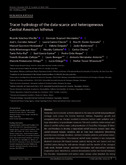Mostrar el registro sencillo del ítem
Tracer hydrology of the data-scarce and heterogeneous Central American Isthmus
| dc.contributor.author | Sánchez-Murrillo, Ricardo | |
| dc.contributor.author | Esquivel-Hernández, Germain | |
| dc.contributor.author | Corrales-Salazar, José L. | |
| dc.contributor.author | Castro-Chacón, Laura | |
| dc.contributor.author | Durán-Quesada, Ana M. | |
| dc.contributor.author | Guerrero-Hernández, Manuel | |
| dc.contributor.author | Delgado, Valeria | |
| dc.contributor.author | Barbereba, Javier | |
| dc.contributor.author | Montenegro-Rayo, Katia | |
| dc.contributor.author | Calderón, Heyddy | |
| dc.contributor.author | 10 autores más. | |
| dc.date.accessioned | 2021-02-18T03:06:50Z | |
| dc.date.available | 2021-02-18T03:06:50Z | |
| dc.date.issued | 2020 | |
| dc.identifier.uri | DOI: 10.1002/hyp.13758 | |
| dc.identifier.uri | https://repositorio.catie.ac.cr/handle/11554/10320 | |
| dc.description.abstract | Numerous socio-economic activities depend on the seasonal rainfall and groundwater recharge cycle across the Central American Isthmus. Population growth and unregulated land use changes resulted in extensive surface water pollution and a large dependency on groundwater resources. This work combines stable isotope variations in rainfall, surface water, and groundwater of Costa Rica, Nicaragua, El Salvador, and Honduras to develop a regionalized rainfall isoscape, isotopic lapse rates, spatial–temporal isotopic variations, and air mass back trajectories determining potential mean recharge elevations, moisture circulation patterns, and surface water– groundwater interactions. Intra-seasonal rainfall modes resulted in two isotopically depleted incursions (W-shaped isotopic pattern) during the wet season and two enriched pulses during the mid-summer drought and the months of the strongest trade winds. Notable isotopic sub-cloud fractionation and near-surface secondary evaporation were identified as common denominators within the Central American Dry Corridor. Groundwater and surface water isotope ratios depicted the strong orographic separation into the Caribbean and Pacific domains, mainly induced by the governing moisture transport from the Caribbean Sea, complex rainfall producing systems across the N-S mountain range, and the subsequent mixing with local evapotranspiration, and, to a lesser degree, the eastern Pacific Ocean fluxes. Groundwater recharge was characterized by (a) depleted recharge in highland areas (72.3%), (b) rapid recharge via preferential flow paths (13.1%), and enriched recharge due to near-surface secondary fractionation (14.6%). Median recharge elevation ranged from 1,104 to 1,979 m a.s.l. | es_ES |
| dc.language.iso | en | es_ES |
| dc.relation.ispartof | Hydrological Processes, (2020), pages 1–16. | es_ES |
| dc.rights | info:eu-repo/semantics/openAccess | es_ES |
| dc.subject | HIDROLOGIA | es_ES |
| dc.subject | SOCIOECONÓMICO | es_ES |
| dc.subject | AGUAS SUBTERRANEAS | es_ES |
| dc.subject | CONTAMINACION | es_ES |
| dc.subject | RECURSOS HIDRICOS | es_ES |
| dc.subject | ISOTOPOS | es_ES |
| dc.subject | AGUA SUPERFICIAL | es_ES |
| dc.subject | HUMEDAD | es_ES |
| dc.subject | SOSTENIBILIDAD | es_ES |
| dc.subject | AMERICA CENTRAL | es_ES |
| dc.title | Tracer hydrology of the data-scarce and heterogeneous Central American Isthmus | es_ES |
| dc.type | Artículo | es_ES |


